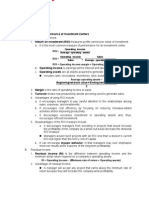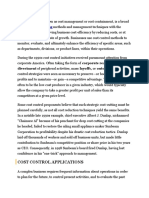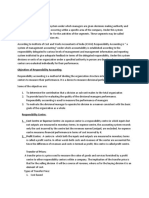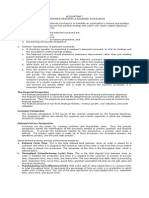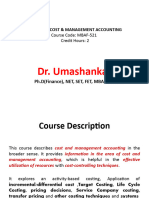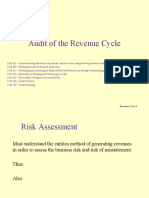Module 4 - Responsibility Accounting
Module 4 - Responsibility Accounting
Uploaded by
Francis Ryan PorquezCopyright:
Available Formats
Module 4 - Responsibility Accounting
Module 4 - Responsibility Accounting
Uploaded by
Francis Ryan PorquezOriginal Description:
Copyright
Available Formats
Share this document
Did you find this document useful?
Is this content inappropriate?
Copyright:
Available Formats
Module 4 - Responsibility Accounting
Module 4 - Responsibility Accounting
Uploaded by
Francis Ryan PorquezCopyright:
Available Formats
MODULE 4
Management Advisory Services 2
SESSION TOPIC 4 : Responsibility Accounting and Transfer Pricing
LEARNING OUTCOMES:
The following specific learning objectives are expected to be realized at the end of the session:
1. Introduce concepts and techniques for performance measurement.
2. Discuss and give appreciation to responsibility accounting and transfer pricing.
KEY POINTS
Responsibility Accounting Responsibility Center Transfer Pricing
CORE CONTENT
Introduction:
This module covers the discussion of
a. Responsibility Accounting;
b. Transfer Pricing.
IN-TEXT ACTIVITY
What is Responsibility Accounting?
Responsibility accounting is a system that involves identifying responsibility centers and their objectives, developing
performance measurement schemes, and preparing and analyzing performance reports of the responsibility centers.
Responsibility accounting involves gathering and reporting revenues and costs by areas of responsibility.
Advantages of Responsibility Accounting
1. Responsibility accounting delegates decision making. Line managers, department heads, and supervisors are
entrusted with operational decisions. The top management (executives) could then focus on strategic or long-term
organizational objectives.
2. It provides a guide to the evaluation of performance. It helps to establish standards which are used for comparison with
actual results.
3. It promotes management by objectives and management by exception.
Management by Objectives and Management by Exception
Management by objectives is an approach in which a manager agrees on a set of goals or objectives (hence the term
management by objective). The performance of the manager and his or her subordinates are evaluated based on
achievement of these goals.
Management by exception is another managerial approach in which management gives attention to matters that
materially deviate from established standards. For example: when a department has very high costs compared to what
was budgeted, the management will focus on finding out the reason behind it and fixing the concern perhaps by cutting
costs, process re-engineering, establishing new standards, etc.
Requisites of Effective Responsibility Accounting
For effective implementation of responsibility accounting, the following must be met.
1. A well-defined organizational structure. Authority and responsibility must be clearly established and understood by all
levels of management.
2. Performance evaluation measures and standards must be clearly established.
3. Only items that are under the influence of the manager of the responsibility center are included in performance
evaluation reports. The manager should not be evaluated based on matters that are out of his or her control.
Responsibility Centers
A responsibility center can be classified according to control over costs, revenues, and investments.
ACCN16B Management Advisory Services 2 JC Sison 1
1. Cost center - A sub-unit of the organization that has control over cost only. It has no control over revenues and
investments. Examples include: production department, maintenance department, accounting department, legal
department, etc. Cost centers are evaluated using variance analysis of costs.
2. Revenue center - has control over revenue generation, but has no control over costs and investment, e.g. the sales
and marketing department. Revenue centers are evaluated using variance analysis of revenues.
3. Profit center - has control over both revenues and costs. Examples include branches operating in different geographic
locations. The performance of profit centers are evaluated by measuring segment income (based on controllable
revenues and costs).
4. Investment center - A sub-unit that has control over revenues, costs, and investments (assets such as receivables,
inventory, fixed assets, etc.). Since investment centers are given authority to decide over its investments, it operates like a
separate entity. Examples include corporate headquarters and subsidiaries. Investment centers are evaluated using
different profitability measures such as return on investment, residual income, economic value-added, and others.
What Is Transfer Pricing?
Transfer pricing is an accounting practice that represents the price that one division in a company charges another
division for goods and services provided. Transfer pricing allows for the establishment of prices for the goods and services
exchanged between a subsidiary, an affiliate, or commonly controlled companies that are part of the same larger
enterprise. Transfer pricing can lead to tax savings for corporations, though tax authorities may contest their claims.
How Transfer Pricing Works?
Transfer pricing is an accounting and taxation practice that allows for pricing transactions internally within businesses and
between subsidiaries that operate under common control or ownership. The transfer pricing practice extends to cross-
border transactions as well as domestic ones.
A transfer price is used to determine the cost to charge another division, subsidiary, or holding company for services
rendered. Typically, transfer prices are priced based on the going market price for that good or service. Transfer pricing
can also be applied to intellectual property such as research, patents, and royalties.
Multinational companies (MNC) are legally allowed to use the transfer pricing method for allocating earnings among their
various subsidiary and affiliate companies that are part of the parent organization. However, companies at times can also
use (or misuse) this practice by altering their taxable income, thus reducing their overall taxes. The transfer pricing
mechanism is a way that companies can shift tax liabilities to low-cost tax jurisdictions.
Transfer Pricing and Taxes
To better understand how transfer pricing impacts a company's tax bill, let's consider the following scenario. Let's say that
an automobile manufacturer has two divisions: Division A, which manufacturers software while Division B manufactures
cars.
Division A sells the software to other carmakers as well as its parent company. Division B pays Division A for the software
typically at the prevailing market price that Division A charges other carmakers.
Let's say that Division A decides to charge a lower price to Division B instead of using the market price. As a result,
Division A's sales or revenues are lower because of the lower pricing. On the other hand, Division B's costs of goods sold
(COGS) are lower, increasing the division's profits. In short Division A's revenues are lower by the same amount as
Division B's cost savings—so there's no financial impact on the overall corporation.
However, let's say that Division A is in a higher tax country than Division B. The overall company can save on taxes by
making Division A less profitable and Division B more profitable. By making Division A charge lower prices and pass those
savings onto Division B, boosting its profits through a lower COGS, Division B will be taxed at a lower rate. In other words,
Division A's decision not to charge market pricing to Division B allows the overall company to evade taxes.
ACCN16B Management Advisory Services 2 JC Sison 2
In short, by charging above or below the market price, companies can use transfer pricing to transfer profits and costs to
other divisions internally to reduce their tax burden. Tax authorities have strict rules regarding transfer pricing to attempt to
prevent companies from using it to avoid taxes.
Transfer Price and Managerial Accounting
In managerial accounting, the transfer price represents the price at which one subsidiary, or upstream division, of a
company, sells goods and services to another subsidiary, or downstream division. Goods and services can include labor,
components, parts used in production, and general consulting services.
Transfer prices affect three managerial accounting areas.
First, transfer prices determine costs and revenues among transacting divisions, affecting the performance of each
division.
Second, transfer prices affect division managers' incentives to sell goods either internally or externally. If the transfer
price is too low, the upstream division may refuse to sell its goods to the downstream division, potentially impairing
the company's profit-maximizing goal.
Finally, transfer prices are especially important when products are sold across international borders. The transfer
prices affect the company's tax liabilities if different jurisdictions have different tax rates.
Determining a Transfer Price
Transfer prices can be determined under the market-based, cost-based, or negotiated method. Under the market-based
method, the transfer price is based on the observable market price for similar goods and services.
Under the cost-based method, the transfer price is determined based on the production cost plus a markup if the
upstream division wishes to earn a profit on internal sales.
Finally, upstream and downstream divisions' managers can negotiate a transfer price that is mutually beneficial for each
division.
Impact of a Transfer Price
Transfer prices determine the transacting division's costs and revenues. If the transfer price is too low, the upstream
division earns a smaller profit, while the downstream division receives goods or services at a lower cost.
This affects the performance evaluation of the upstream and downstream divisions in opposite ways. For this reason,
many upstream divisions price their goods and services as if they were selling them to an external customer at a market
price.
If the upstream division manager has a choice of selling goods and services to outside customers and the transfer price is
lower than the market price, the upstream division may refuse to fulfill internal orders and deal exclusively with outside
parties.
Even though this can bring extra profit, this may harm the overall organization's profit-maximizing objective in the long
term. Similarly, a high transfer price may provide the downstream division with the incentive to deal exclusively with
external suppliers, and the downstream division may suffer from unused capacity.
Transfer Prices and Tax Liabilities
Transfer prices play a large role in determining the overall organization's tax liabilities. If the downstream division is
located in a jurisdiction with a higher tax rate compared to the upstream division, there is an incentive for the overall
organization to make the transfer price as high as possible. This results in a lower overall tax bill for the entire
organization.
However, there is a limit to what extent multinational organizations can overprice their goods and services for internal
sales purposes. A host of complicated tax laws in different countries limit the ability to manipulate transfer prices.
The Bottom Line
ACCN16B Management Advisory Services 2 JC Sison 3
The transfer price impacts the performance of both subsidiaries that transact with one another. A price that is too low
disincentivizes an upstream division from selling to a downstream division as it results in lower revenues. A price that is
too high disincentives the downstream division from buying from the upstream division, as costs are too high.
Arriving at a fair transfer price is not only beneficial to both subsidiaries but allows a company to reach profit maximization,
as well as allowing a company to possibly take advantage of favorable tax setups.
SESSION SUMMARY
Responsibility accounting involves the separate reporting of revenues and expenses for each responsibility center in
a business. Doing so improves the management of operations. For example, the cost of rent can be assigned to the
person who negotiates and signs the lease, while the cost of an employee’s salary is the responsibility of that
person’s direct manager. This concept also applies to the cost of products, for each component part has a standard
cost (as listed in the item master and bill of materials), which it is the responsibility of the purchasing manager to
obtain at the correct price. Similarly, scrap costs incurred at a machine are the responsibility of the shift manager.
Transfer pricing is an accounting practice that represents the price that one division in a company charges another
division for goods or services provided.
A transfer price is based on market prices in charging another division, subsidiary, or holding company for services
rendered.
However, companies have used inter-company transfer pricing to reduce the tax burden of the parent company.
Companies charge a higher price to divisions in high-tax countries (reducing profit) while charging a lower price
(increasing profits) for divisions in low-tax countries.
The transfer price is the price that goods and services are sold by one subsidiary in a company to another subsidiary
in a company.
The goods and services that subsidiaries sell to one another can include labor, manufacturing parts, and other
supplies.
Transfer prices impact three managerial accounting areas: division performance, managerial incentives, and taxes.
Transfer prices can be determined under the market-based, cost-based, or negotiated method.
Depending on the tax jurisdictions of both subsidiaries, transfer pricing can improve a company's overall tax burden.
The transfer price affects the performance of both subsidiaries in opposite ways.
SELF-ASSESSMENT
Assignment : Computation on responsibility accounting and transfer pricing
Quiz : Problem on responsibility accounting and transfer pricing
REFERENCES
Refer to the references listed in the syllabus of the subject.
ACCN16B Management Advisory Services 2 JC Sison 4
You might also like
- Accounting and Bookkeeping Business PlanDocument45 pagesAccounting and Bookkeeping Business PlanDOZYENo ratings yet
- Intermediate Accounting 1: a QuickStudy Digital Reference GuideFrom EverandIntermediate Accounting 1: a QuickStudy Digital Reference GuideNo ratings yet
- Responsibility AccountingDocument7 pagesResponsibility AccountingMarilou Olaguir SañoNo ratings yet
- Investment Centers and Transfer PricingDocument9 pagesInvestment Centers and Transfer PricingMohammad Nurul AfserNo ratings yet
- Cost Accounting Management-I-1Document76 pagesCost Accounting Management-I-1gech95465195No ratings yet
- Responsibility Accounting and Transfer PricingDocument23 pagesResponsibility Accounting and Transfer PricingNekibur DeepNo ratings yet
- ManAccP2 - Responsibility AccountingDocument5 pagesManAccP2 - Responsibility AccountingGeraldette BarutNo ratings yet
- M5 Accele 2Document5 pagesM5 Accele 2PYM MataasnakahoyNo ratings yet
- Part - 1 - Advanced Cost ConceptsDocument23 pagesPart - 1 - Advanced Cost ConceptsDaniel BalchaNo ratings yet
- EbookDocument17 pagesEbookAmol LambrudNo ratings yet
- Cost AssignmentDocument7 pagesCost Assignmenteyobabera527No ratings yet
- Objective of Transfer PricingDocument6 pagesObjective of Transfer PricingYSNo ratings yet
- Financing A Business (Draft)Document21 pagesFinancing A Business (Draft)mkubwihastingsNo ratings yet
- Q.1 Selected Financial Information About Vijay Merchant CompanyDocument11 pagesQ.1 Selected Financial Information About Vijay Merchant CompanyUttam SinghNo ratings yet
- IntroDocument37 pagesIntrowfd52muni100% (1)
- Cost Accounting: Divestment of Peripheral Activities, Mass Layoffs, or Outsourcing, CostDocument11 pagesCost Accounting: Divestment of Peripheral Activities, Mass Layoffs, or Outsourcing, Costhiren79111No ratings yet
- Performance MeasurementDocument6 pagesPerformance Measurementcherrymia canomayNo ratings yet
- Unit 1-4Document104 pagesUnit 1-4ዝምታ ተሻለNo ratings yet
- MB0041 AccountsDocument10 pagesMB0041 AccountsvermaksatishNo ratings yet
- Cost Accounting Viva - 045411Document23 pagesCost Accounting Viva - 045411MD: TonuNo ratings yet
- Arbaminch University: Colege of Business and EconomicsDocument13 pagesArbaminch University: Colege of Business and EconomicsHope KnockNo ratings yet
- Responsibility AccountingDocument15 pagesResponsibility AccountingSudipto RoyNo ratings yet
- Class 10Document12 pagesClass 10carlaNo ratings yet
- Polytechnic University of The Philippines: Chapter 4 (Part 2) : Expense CentresDocument10 pagesPolytechnic University of The Philippines: Chapter 4 (Part 2) : Expense CentresJeffrey MangsatNo ratings yet
- Short Notes Chapter-5,6,7,8Document7 pagesShort Notes Chapter-5,6,7,8Rakib IslamNo ratings yet
- Responsibility Accountin1Document3 pagesResponsibility Accountin1mkk619No ratings yet
- Chapter 7 Decentralization and Transfer PricingDocument34 pagesChapter 7 Decentralization and Transfer Pricingtamirat tadeseNo ratings yet
- SPM Chapter 7Document5 pagesSPM Chapter 7Rika KartikaNo ratings yet
- Group 4 ReportDocument36 pagesGroup 4 ReportKatrinaDelaCruzNo ratings yet
- Cost CH 6Document10 pagesCost CH 6Abayineh MesenbetNo ratings yet
- Segmented Reporting, Investment Center Evaluation, and Transfer PricingDocument3 pagesSegmented Reporting, Investment Center Evaluation, and Transfer Pricingeskelapamudah enakNo ratings yet
- Responsibility Accounting in McsDocument5 pagesResponsibility Accounting in McsRajesh WariseNo ratings yet
- What The Concept of Free Cash Flow?Document36 pagesWhat The Concept of Free Cash Flow?Sanket DangiNo ratings yet
- Responsibility Centers: Revenue and Expense CentersDocument21 pagesResponsibility Centers: Revenue and Expense CentersMohammad Sabbir Hossen SamimNo ratings yet
- Accounting and FinanceDocument4 pagesAccounting and FinanceMuhammad WaqasNo ratings yet
- Script For Responsibility AccountingDocument4 pagesScript For Responsibility Accountingellamangapis2003No ratings yet
- Fundamental of CostingDocument24 pagesFundamental of CostingCharith LiyanageNo ratings yet
- AIOU8408 Assignment 1 0000603169Document18 pagesAIOU8408 Assignment 1 0000603169Farhan ShakilNo ratings yet
- cost 2Document19 pagescost 2natiman8399No ratings yet
- Acc7 Perf MeasuresDocument7 pagesAcc7 Perf MeasuresZerjo CantalejoNo ratings yet
- Cost AccountinDocument144 pagesCost AccountinbrianNo ratings yet
- Cost and Management AccountingDocument52 pagesCost and Management Accountings.lakshmi narasimhamNo ratings yet
- 09435BBA305 - Notes (Module 1)Document11 pages09435BBA305 - Notes (Module 1)Divakar Pratap SinghNo ratings yet
- Cost Structure For CompaniesDocument21 pagesCost Structure For CompaniesJuan LamasNo ratings yet
- Cost Chapter 6Document25 pagesCost Chapter 6Yonas AltayeNo ratings yet
- Responsibility CentresDocument9 pagesResponsibility Centresparminder261090No ratings yet
- 8 Responsibility Accounting Transfer Price and Balance ScorecardDocument9 pages8 Responsibility Accounting Transfer Price and Balance ScorecardAlliah Mae ArbastoNo ratings yet
- Microsoft Word - EPM - Short NotesDocument8 pagesMicrosoft Word - EPM - Short NotesAnita SurwadeNo ratings yet
- Chapter 1Document60 pagesChapter 1Daniel BalchaNo ratings yet
- Responsibility Accounting Responsibility Accounting - A System of Accounting Wherein Costs and RevenuesDocument3 pagesResponsibility Accounting Responsibility Accounting - A System of Accounting Wherein Costs and RevenuesAriel DicoreñaNo ratings yet
- CostaccountingDocument30 pagesCostaccountingAtwijukye ArthurNo ratings yet
- Budgeting Chapter. SixDocument22 pagesBudgeting Chapter. SixTatasha Takaye KasitoNo ratings yet
- Assignment 1Document9 pagesAssignment 1Yashveer SinghNo ratings yet
- 2Document21 pages2NABILAH KHANSA 1911000089No ratings yet
- Basic Types of Responsibility CentersDocument5 pagesBasic Types of Responsibility CentersmeseleNo ratings yet
- Financial ControllershipDocument4 pagesFinancial ControllershipjheL garciaNo ratings yet
- Unit 12 Responsibility Accounting and Performance MeasuresDocument16 pagesUnit 12 Responsibility Accounting and Performance Measuresestihdaf استهدافNo ratings yet
- Responsibility AccountingDocument6 pagesResponsibility AccountingAnuradha MauryaNo ratings yet
- Every SBU Is A Profit Center But Every Profit Center Is Not A SBUDocument4 pagesEvery SBU Is A Profit Center But Every Profit Center Is Not A SBUDivyesh NagarkarNo ratings yet
- AIS6e.ab - Az ch04Document46 pagesAIS6e.ab - Az ch04Francis Ryan PorquezNo ratings yet
- CH04 Introduction To EthicsDocument12 pagesCH04 Introduction To EthicsFrancis Ryan PorquezNo ratings yet
- Opmn03b - M7Document3 pagesOpmn03b - M7Francis Ryan PorquezNo ratings yet
- CH07 Introduction To Risk ManagementDocument20 pagesCH07 Introduction To Risk ManagementFrancis Ryan PorquezNo ratings yet
- SBAN11B MODULE 6 Corporate Social ResponsibilityDocument5 pagesSBAN11B MODULE 6 Corporate Social ResponsibilityFrancis Ryan PorquezNo ratings yet
- Opmn03b M2Document4 pagesOpmn03b M2Francis Ryan PorquezNo ratings yet
- SBAN11B MODULE 1 IntroductionDocument4 pagesSBAN11B MODULE 1 IntroductionFrancis Ryan PorquezNo ratings yet
- Module 5 - Master BudgetDocument6 pagesModule 5 - Master BudgetFrancis Ryan PorquezNo ratings yet
- Module 3 - Strategic Cost ManagementDocument7 pagesModule 3 - Strategic Cost ManagementFrancis Ryan PorquezNo ratings yet
- Module 2 - Activity Based CostingDocument3 pagesModule 2 - Activity Based CostingFrancis Ryan PorquezNo ratings yet
- (New RPP) Strategic Finance Associate - CEO Office RPP AnswerDocument13 pages(New RPP) Strategic Finance Associate - CEO Office RPP AnswerDean ErlanggaNo ratings yet
- One Simple Idea That Explains Why The Economy Is in Great Danger - The New York TimesDocument2 pagesOne Simple Idea That Explains Why The Economy Is in Great Danger - The New York TimesJustBNo ratings yet
- Attention C.A. PCC & Ipcc Students: (No.1 Institute of Jharkhand)Document17 pagesAttention C.A. PCC & Ipcc Students: (No.1 Institute of Jharkhand)sai2bbp6bsNo ratings yet
- Broiler ProductionDocument5 pagesBroiler ProductionguhilingprincejohnNo ratings yet
- Accounting Mid-Term Exam Acct.Document3 pagesAccounting Mid-Term Exam Acct.Ann ButlerNo ratings yet
- Audit of The Revenue CycleDocument62 pagesAudit of The Revenue CycleEdgar Belono-ac Jr.No ratings yet
- How To Start Business of PP-HDPE Woven Bag, Circular Loom, Plastic BagDocument60 pagesHow To Start Business of PP-HDPE Woven Bag, Circular Loom, Plastic BagNitinNo ratings yet
- Income Tax Revision QuestionsDocument13 pagesIncome Tax Revision QuestionsMbeiza MariamNo ratings yet
- Financial Statement Analysis: AnDocument82 pagesFinancial Statement Analysis: AnMadalin PotcoavaNo ratings yet
- Financial AccountingDocument159 pagesFinancial AccountingTRINI100% (2)
- Accounting Ratios of HUL LTDDocument11 pagesAccounting Ratios of HUL LTDSaloni LohiaNo ratings yet
- 2 Rajesh SinghDocument156 pages2 Rajesh Singhmohammadshahid91No ratings yet
- Salesforce DeploymentDocument15 pagesSalesforce DeploymentMufaddal HussainNo ratings yet
- Leac 205Document47 pagesLeac 205Harish Singh NegiNo ratings yet
- Spice Oleoresins PDFDocument63 pagesSpice Oleoresins PDFaarklnarayanaNo ratings yet
- ARBAJ Print - Udyam Registration CertificateDocument4 pagesARBAJ Print - Udyam Registration Certificatedeepakgaur3139No ratings yet
- Carton Project PDFDocument71 pagesCarton Project PDFVikas KhichiNo ratings yet
- Chapter 12Document17 pagesChapter 12Jemaicah AmatiagaNo ratings yet
- Cloud Mustang Executive SummaryDocument7 pagesCloud Mustang Executive SummarygowrishhhhNo ratings yet
- Mitchell's Fruit Farms Ltd. Fundamental Company Report Including Financial, SWOT, Competitors and Industry AnalysisDocument13 pagesMitchell's Fruit Farms Ltd. Fundamental Company Report Including Financial, SWOT, Competitors and Industry Analysisarslan shahzadNo ratings yet
- Camels: Rose - Chapter 16 #1Document27 pagesCamels: Rose - Chapter 16 #1Lê Chấn Phong100% (1)
- TOPIC 1 - PUBLIC SECTOR ACCOUNTING STANDARDS (IPSAs)Document13 pagesTOPIC 1 - PUBLIC SECTOR ACCOUNTING STANDARDS (IPSAs)samnjiru466No ratings yet
- Revenue Recognition: Long Term ConstructionDocument3 pagesRevenue Recognition: Long Term ConstructionLee SuarezNo ratings yet
- Practice QuestionsDocument353 pagesPractice QuestionsAwais MehmoodNo ratings yet
- Nepra Annual Report 2010-2011Document151 pagesNepra Annual Report 2010-2011Hassan RazaNo ratings yet
- AHM Chapter 1 - SolutionsDocument26 pagesAHM Chapter 1 - SolutionsNitin KhareNo ratings yet
- Part1 SU1 2015 Rev2Document86 pagesPart1 SU1 2015 Rev2Mustafa Tevfik ÖzkanNo ratings yet
- MGT401 Mega Quiz File by Innocent Prince: Current AssetDocument38 pagesMGT401 Mega Quiz File by Innocent Prince: Current AssetSana UllahNo ratings yet
- PRESENTATION ON Finincial Statement FinalDocument28 pagesPRESENTATION ON Finincial Statement FinalNollecy Takudzwa Bere100% (2)



